#plants died. save for 1 tomato plant. and one that I bought from a garden store
Explore tagged Tumblr posts
Text
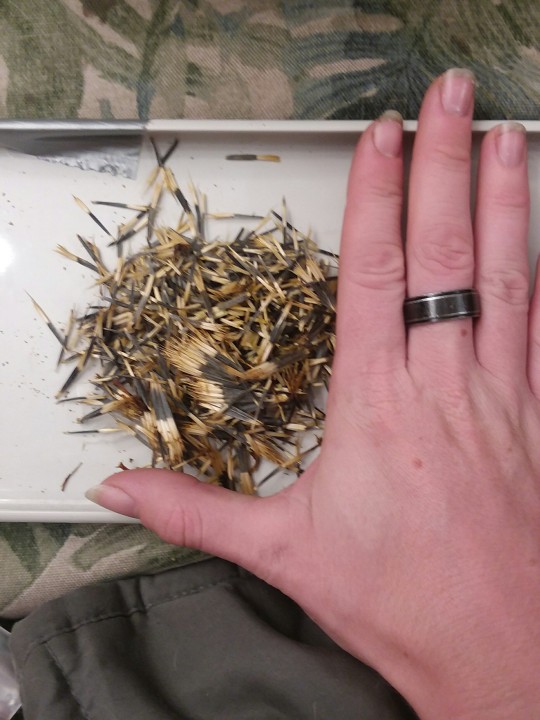
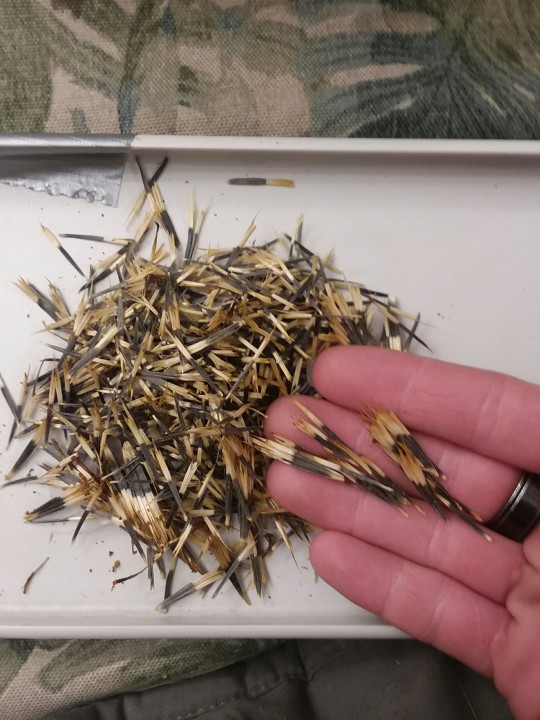

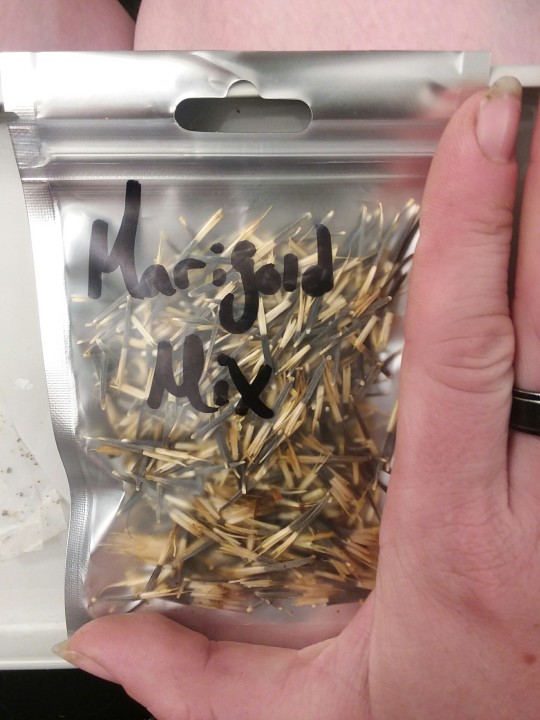
You know how when you buy a packet of Marigold seeds, it seems like 99% of the package is air, and there's maybe ten, wispy seeds at the bottom of the pack?
Yeah. This is why you should seed save, it is rediculously easy.
I forgot to take picture of the actual (very easy) process, but that HANDFUL of seeds up there? That's from, maybe 7 flowerheads.
All you gotta do to save a fortune and save a million seeds, for Marigolds?
As you're walking past your flowers and you see dead, dried up flowerheads?
Snag them off the plant. Pluck them off, and they'll come off with a quick tug. Stick them in a little plastic bag until you've gathered all of the current seedheads.
Bring your bag inside to a table with a little bowl and your seed's final destination (I used a resealable mylar bag I bought in a pack of 200 purely for seeds and seedsaving).
Then, simply pull the dead flower petals off the top, pull out the main seeds in the center from their frizzy tops, and then, just when you thought you got them all, unroll the flower head entirely and find 20 more lining the inside.
7 seed heads, maybe two minutes of work, and now, I've got hundreds of Marigold seeds, and the flowers outside still have dozens of blooms on them, all of them able to give more and more seeds.
If you garden, you should be seed saving! You don't even need any fancy equipment, just get some ziplock sandwich baggies and a sharpie, and you're good to go!
If you buy Winter Squash,tomatoes, ripe Peppers (Yellow, orange, and red), any kind of dried bean, cantaloupe, seeded watermelon, berries, and any kind of ripe fruit that has seed?
You can rinse, dry, and save those seeds for planting.
You can get free future food from your current food, at no extra cost.
Now, granted, some of the seeds you plant might not be exactly the same as the food you got it from; maybe the food you bought was a hybrid variety, so it might not taste or look the same, but that's not always a bad thing, and even if the end result wasn't identical to the food you bought... This is still free food that you would otherwise not have.
Especially right now, during the Coronavirus Crisis of 2020, when so many people are at home, out of work, and out in the garden for the first time, doing everything they can to provide for their families, seed saving is more important than ever!
If you grow summer squash in your garden, leave 1 squash on at least 1 plant to grow, unpicked until the plant dies, and then harvest them for hundreds of seeds instead of spending $1 for five seeds next year and every year.
If you grow green beans, make sure you leave a few pods to dry completely on the vine to have seed for next year!
Don't buy seed packets for pinto, black, kidney, or garbanzo beans, instead, head over to the cooking section of the store and pick up one pound bags of each variety for under $2 a pop, or even just a bag of Ham 'N' Beans 15 Bean mix, stick them in a cup of water overnight (or snag then from your stockpot before you cook them), and pop them anywhere in the garden that they can climb something, since most of them will be "pole" varieties that climb.
If you're looking to invest far into the future and don't mind a bit of a gamble? Keep your tree fruit seeds. I'm talking citrus like lemons, oranges, mandarins, limes, stone fruits like cherries, peaches, apricots, plums, any kind of apples, pomegranates, avacados, etc. They'll take at LEAST a few years to fruit, but that just means you've got food in the future just waiting for you.
Save your seeds, and whenever possible, educate and help others do the same, and help everyone have more food security, knowing they can grow their own, even in just some sterlite storage containers on the porch.
24 notes
·
View notes
Text
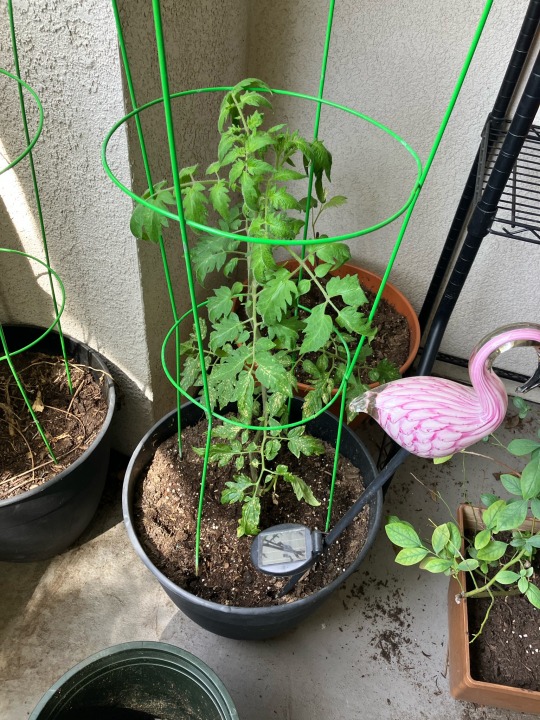
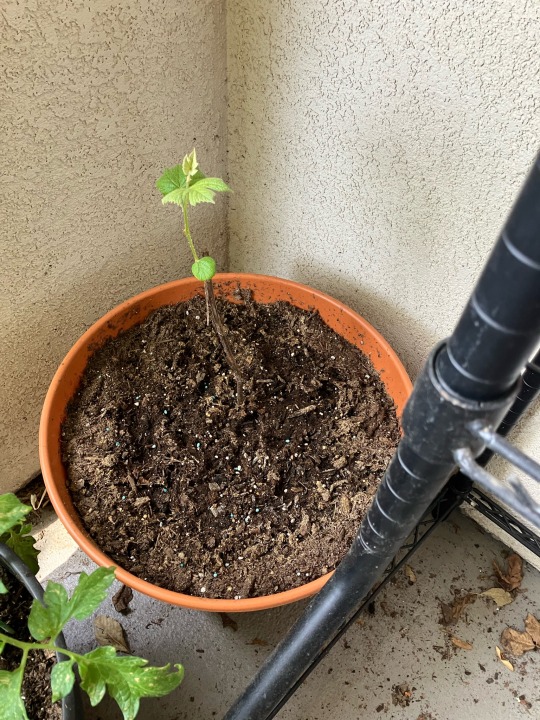
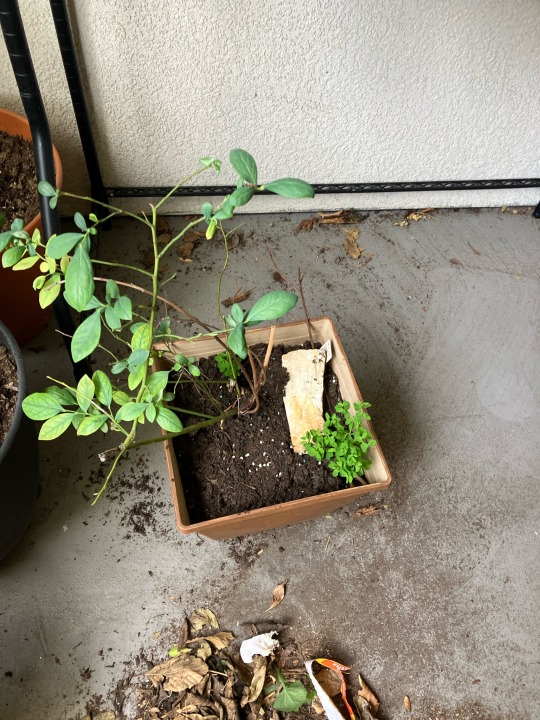
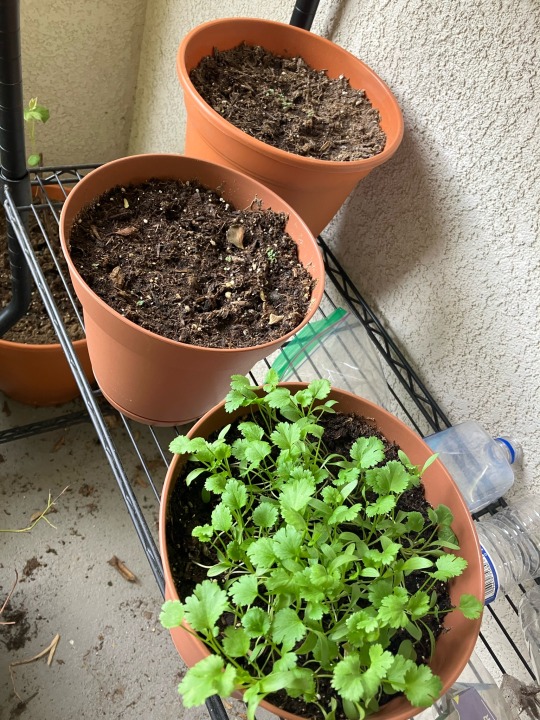
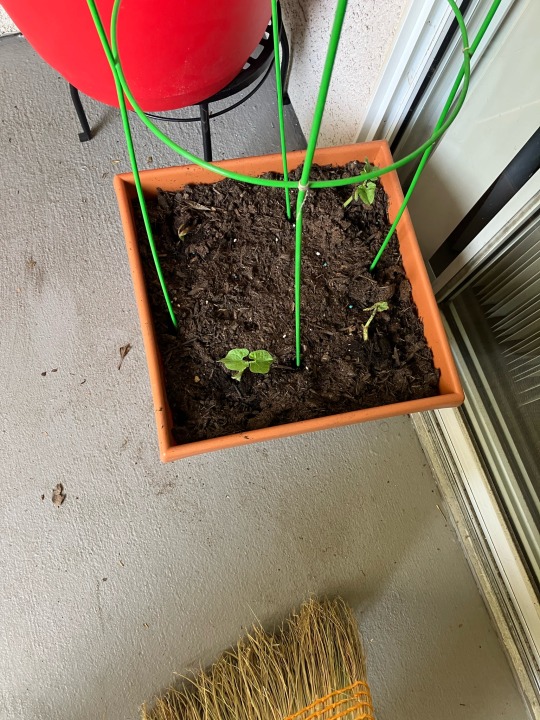
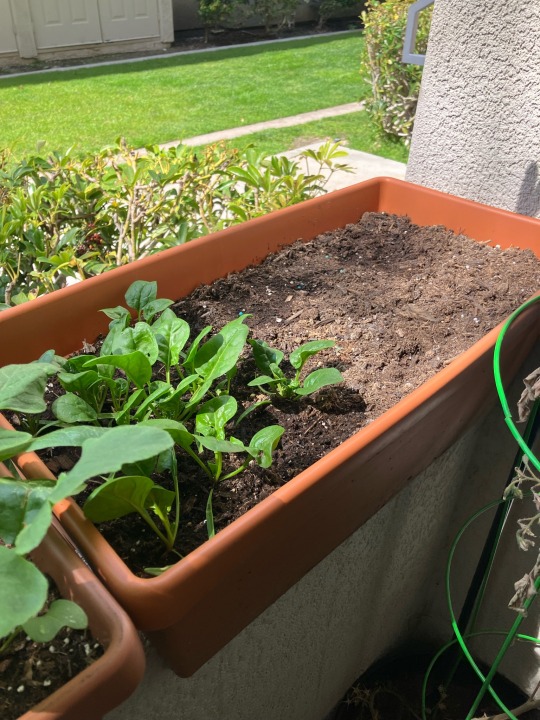
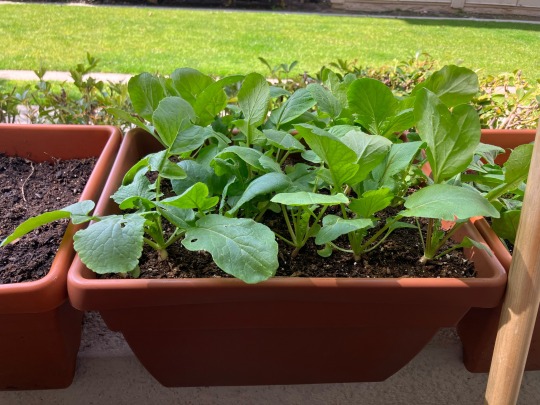
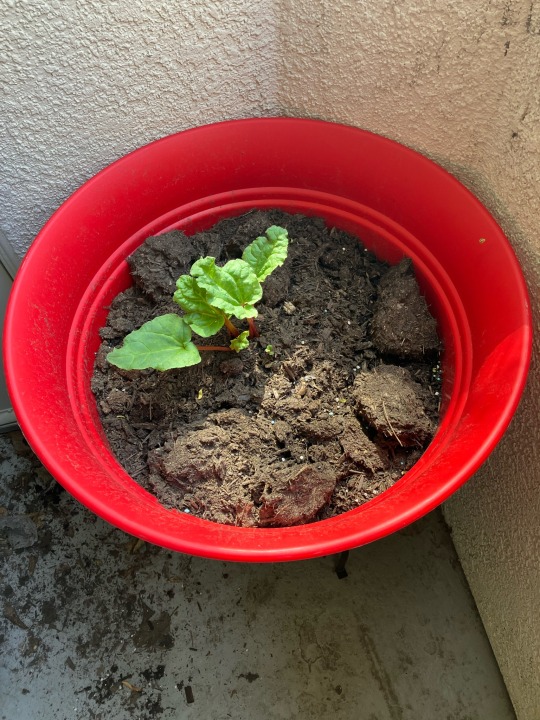
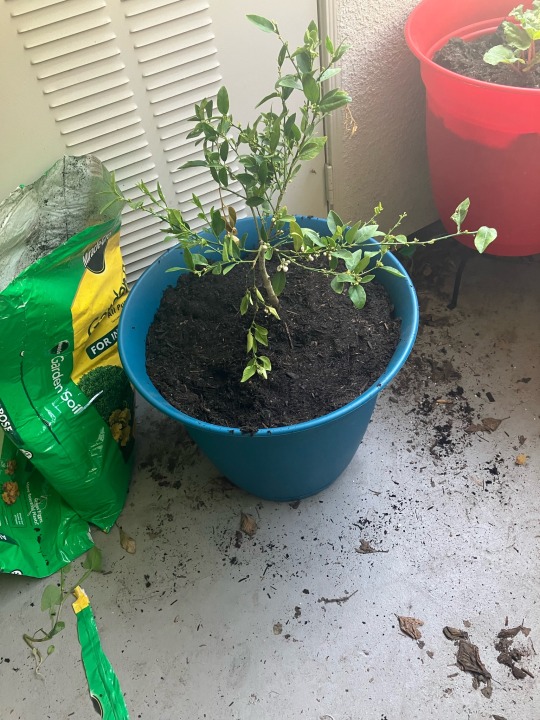
My garden is done almost done!
Photo 1- Beefsteak Tomato plant (to its left is the almost-dead-soon-to-be-removed yellow pear tomato plant that has a fungus? Virus? Idk but it will be replaced by cucumbers in about 2 weeks once the cucumbers sprout)
Photo Dos- Grapes. Had grapes at my parents house when we moved in when I was 6. Immediately removed b/c it’s like cyanide to dogs. Those grapes have been haunting my dreams for 21 years. So I bought my own to grow.
Third Photo- the Goddamn Fuckin Invincible Blueberry Bush that I bought in early 2020 when Covid was everywhere. It refused to die when I left it at my apartment for 4 months in the middle of the SoCal summer. It has some fruit growing on it. It is My Beloved and as a treat I gave it some fresh soil
4rd Photo- Herbs, my other beloveds. We got Cilantro, thyme, and oregano. No, I don’t know which is thyme and which is oregano. Fun fact: I’ve been cooking with cilantro for like 2 years with my boyfriend and last week he finally told me that he isn’t a fan. He doesn’t taste soap, it’s just too potent. I am still Shook.
Photo Number 5: Beans beans the magical fruit. The more you eat the more you toot. The more you toot the better you feel, so beans beans for every meal. No, I will not elaborate.
Image 6: spinach. Because I can never finish a bag of Popeye’s favorite food before it goes bad. Now I can just pick what I need. To the right is some lettuce that hasn’t sprouted yet. I’ve unintentionally planted things in phases b/c I am a lazy ass
Image 7: Radishes, almost Ready for Harvest (and then they will be PICKLED, and then I shall consume. All. Of. Them.) in the planter to the right is a strawberry plant and dill, when it decides to get the show on the road. I’m patient.
Photo 8: ya so this is rhubarb and funny story: the beefsteak tomato plant went into the Rhubarb’s original pot b/c I thought I’d kill the rhubarb (no one told me it died off and grew back). So I pulled out this root-thing that looked like mutant ginger, realized it was the ‘dead’ rhubarb, and uh… ripped off the white fleshy covering thing that protects the baby stalks. So I thought I’d killed it again but replanted it in the red pot just in case. And now it’s back. It’s giving the blueberry bush a run for the ‘invincible’ title. This isn’t even my plant, it’s my dad’s that I bought him last year for his birthday.
Nine: the lime tree I just transplanted. Boyfriend requested lime tree for alcohol-related reasons. I just like the smell of the blossoms. It scored a few direct hits on my hands before I stole a pair of gardening gloves from my parents (in my defense, my parents are 3 minutes away, and the dog has a habit of eating gardening gloves so really I’ve preemptively saved the gloves from Mr Dingus)
Not shown:
the partially dead Jalapeño plant who did not like how cold the winter got. I’m hoping he perks up now that it’s usually above 60 degrees. About four of its children are in our freezer b/c I keep forgetting about them whenever I make soup
A strawberry plant that was a hitchhiker from the long brown pots, technically is my mother’s but she a-didn’t know it was there and b- I put it in my special favorite purple pot so it’s mine forever now
Daffodils that are theoretically going to flower? Idk. I just water them and tell them they’re pretty just how they are
2 soil pods that will hopefully sprout cucumber plants in a week. For pickling reasons.
Some green onions I’ve shoved into the other pots after I took these photos.
Christmas fern/ivy/poinsettia thingy next to my front door, from the fine purveyors of Costco.
Also the flamingo thing lights up and he needs a name.
#Carter’s garden#I AM SUCCESSFUL at this so far#I know the beans will do good b/c I always had luck as a kid with peas#the only downside of the patio garden is that there’s no hose connection#so to water everything I take a 2L soda bottle to the bathtub to fill it up#it’s about 4 trips to water everything
1 note
·
View note
Text
Basil and I (Copy)
I have developed a very special relationship with a basil leaf over 18 months.
I bought a packet of basil leaves from a supermarket. I noticed one of the leaves had an unusually long stem.
So, just for fun, I put the leaf into a glass of water. After a while, roots came out. Again, just for fun, I put the stem in a pot with other basil plants on my kitchen window sill. Then it started to shoot! The leaves were spreading out, and it even flowered well before any other basil plants did.
The headmistress (my wise gardener) told me that the indoor plant won’t make seeds because there are no insects to fertilize it. However, she added; “Mind you, some people use a brush for that”.
“Right!” I thought. I felt I should help Mr (or Mrs) Basil to produce their next generation as they are so eager to survive. I used a chopstick made of bamboo which was tapered at the end, and the tip was just the right size for their very tiny, white flowers. I spent an hour or so for a couple of days, making sure some pollen was pushed inside the flowers. Then I forgot about them altogether.
The flowers died away and dried up. I did not expect anything, but lo and behold! I noticed there were small black bits inside!
There were just right number of seeds to spread out in a pot. I buried those seeds just underneath some fresh compost, and left the pot in the conservatory.
Within three days, small leaves started to appear. ‘My goodness! They are so eager to live.’ I thought. And soon, they started to grow healthy leaves. It felt awesome, feeling their life force.
By then, I had been given some tips by a neighbour on how to make my own pesto, and freeze the pesto as ice cubes to use them as required. When I heard this brilliant idea, I looked up a recipe for pesto on line.
I think I should share it with you! Here you go -
Pesto (from damndelicious.net)
1 cup fresh basil leaves; 3 cloves garlic; 3 tablespoons pine nuts; 1/3 cup grated parmesan cheese;
Food process the above.
Then add slowly: Salt and black pepper; 1/3 cup olive oil
My neighbour (who used to live in Italy) even told me that you can freeze the left over pine nuts to stop oxidization. I was so eager to get all the ingredients and try out the recipe. It was amazingly easy. I no longer purchase Pesto in a small glass bottle from super markets.
Photo above - Beans, tomato plants…and “basil” with white tiny flowers - back in May 2021.
hardy basil
Ever since learning how to make my own pesto, I can quickly cook pasta and melt my frozen homemade pesto in it. I serve it with Mozzarella cheese and sun dried tomatoes (which I get regularly from a local deli) whenever I am opting for a simple meal. I can also cater for a fairly large number of guests without any hassle as well.
However, the second generation basil appeared to be attacked by insects (spider mites, so the headmistress said).
I just looked it up and the optimum temperature for spider mites is 27 degrees – no wonder they thrived in my conservatory in the summer. The mites attacked from the lower end of the leaves, which were dried up and fell off. The center piece were still untouched and they even got buds. So, I just picked up a few stems with buds, and put them in water.
Again, massive roots came out! So I planted them in a pot as before. This time the buds did not flourish, but large leaves around the buds grew. These leaves turned out to be so gigantic and when they had grown into a good size, I harvested some large leaves. It easily amounted to 1 cup! I then filled up another ice cube container with home made pesto.
I felt that the little basil leaf I saved from a packet had returned his (or her) gratitude to me...
Thank you, Basil, for sharing your life force... I will not waste it. I will do something positive for this world. After all, we are all channels for the life force. We may look insignificant, but surely we are a part of something immense.
Photo right - Ingredients for pesto…naturally if you use more nuts and cheese, it becomes richer to taste.
Flowers support bees and bees produce honey…and we are all integrated.
0 notes
Text
Fun Facts About Milk
Fun facts about milk. Anybody up for some trivia. “Fun facts about milk” is my topic for today. We have fresh milk again and it is always a treat. There isn’t much milk at this point because Rosie is quite a small cow and it’s her first calf. I’ll talk more about that fun fact in a bit.
I want to take a minute and say welcome to all the new listeners and welcome back to the veteran homestead-loving regulars who stop by the FarmCast for every episode. I appreciate you all so much. I’m so excited to share with you what’s going on at the farm this week.
Our Virginia Homestead Life Updates
I don’t know what it’s like where you are, but spring is starting up here. We can still expect some colder days and our last frost date according to the USDA is April 15th. That’s more than a month away. Still, it is in the upper 60’s today and sunny. In short, it’s a beautiful spring day.
Reblochon Cheese
Before I get into the animal updates, I want to let you know that I just made a brand new cheese that I have never made before. It is still in progress. When I finish this podcast, it will be just about time to put it in the brine solution. Brining is a common method for adding salt to cheese. I’m so excited about this cheese. It is a semi-soft, washed rind cheese. Making it to the point of getting the curds in the molds was very quick and easy. Now the hard part begins. I have never made a rind with this much complexity.
If I am successful, I will have created a creamy, buttery cheese that will ooze and melt at room temperature similar to the way that a brie or camembert will ooze out of the skin. The difference is that there isn’t that skin – and that bloomy rind, mushroomy scent and flavor. This cheese will have a much firmer rind. We shall see how it goes. It’s a new adventure.
Sheep
The sheep are out there milling about looking for every new blade of grass. And there is some out there. Sheep will eat hay, but they prefer fresh grass. It’s not readily available in the winter and they persevere with the hay. But any day you will find them out there seeking at least one blade of fresh grass. Well today they are finding a bit. Granted the blades of grass are few and far between, but there is a bit here and there.
As far as lambs, these beautiful ewes have less than three weeks left before they start giving birth. We anticipate this event every single year. You just can’t not love those little lambs bouncing around, jumping straight up and down in the early evening. Praying for this year to be as good as the last. We are looking for about 6 to 8 healthy lambs.
Cows
A couple of our cow girls are nearing the end of their gestation as well. We could see the next calf as early as two and a half weeks from now. In the coming days, we will begin to start walking the girls up to the milking shed every day. That reminds them of the path and what they need to do to cooperate with the process. Well, they also get a little treat while they are standing there, so that is probably their incentive as they have no care for the process. Walking them up every day also gives us the opportunity to more closely monitor their progress and general health. Any issues are easily spotted and we can respond quickly.
I don’t remember if I talked about this the last time, but we are looking at adding a couple of bred heifers or young cows that are bred and ready to deliver in April or May. That would help us out so much. We are trying to build a specific genetic makeup in all of our cows. We need the A2A2 genetics for our fresh milk herd share members. If you are not familiar with A2A2 milk, I did a podcast on the topic called “What is A2A2 Milk? You’ll find it on our website.
We also need the genetic trait for BB Kappa casein for making cheese. We have lots of A2A2 cows but we are missing the BB kappa casein trait. I believe the only one who has that genetic trait is also not A2A2. As we move forward, there will be significant changes in our herd. It will take the next five years or so for us to reach our goal of 100% A2A2 and 100% BB kappa casein.
Quail
I’m saving eggs to put in the incubator. I think I mentioned that we are giving the quail one more year to pay for themselves. So far so good. I actually have new customers that are buying the quail meat. That helps a lot. The eggs sell fairly well, but there is little profit in eggs. Just sayin . . .
Today I got the incubator down out of the storage area above the creamery. Tomorrow or the next day I will crank it up and the process of hatching those cute little quail babies will begin again.
Garden
Preparing the garden for spring is now on the agenda. There is quite a bit to do out there and these wonderful spring days are just the time to do it. I think beginning the tasks will be delayed a few days due to another project I will talk about in a moment.
Did I mention that I have 500 bare root strawberry plants coming soon? That’s right 500 strawberry plants. Scott loves jam in his yogurt and I’ve been out of strawberry jam for over a year. This year I plan to remedy that problem. And I’ll have some yummy jam for you guys as well.
I have lots of tomato plant starts already sprouting. Also, the basil and thyme are sprouting. It’s so good to be growing stuff again. I have five different herbs, two tomato varieties and eight varieties of pepper plants that I’ve got seeded. Again, only the tomatoes and a couple of herbs have sprouted so far. But I’m actually amazed that those seeds sprouted so quickly. I’ve never seen any of my seeds sprout before 6 or 7 days. These came up in 3 days. Something is going on right now in my growing area this year.
I have an amaryllis – actually there are three in that pot. They are all over 13 years old. They have moved with me a couple of times and have nearly died a couple of times. For the first time in 13 years, one of them bloomed. And she bloomed big. There were three primary blossoms and one that was a little late in coming out. That one is the only one left of the four.
I watched that stalk grow for days and days and days. Then as it started to open, I realized that it had been so long that I had no idea what color the bloom would be. I thought for sure it would be a deep red. Nope. It was white. At this point I’m thinking that the bulbs might be even more than 13 years old as I’m pretty sure that the last one I bought was red. Well, we shall see if any of the others bloom in the future.
Bees
A short note on the bees. I don’t talk about them much. We don’t give them a lot of attention. We have never robbed the honey. For quite a few years they have simply gone on with their business of keeping up their hive all on their own. However, it’s not looking good this time. We don’t know for sure yet, but we may have lost the hive this winter. It was a particularly long and cold winter and they may have not survived. We shall see. It was plenty warm enough today for them to be out and about. There are always a few guarding the door. There was nothing when I went out a little while ago. But maybe it is still too cold inside there. I’ll be very sad if we lose our bees. They pollinate our orchard trees and vegetable garden.
Creamery
On a much happier note, the stairs to the storage area above the kitchen and creamery are currently under construction. What a blessing that will be when it is complete. It was quite the ordeal getting stuff up there. Scott attached a palette to the front forks on the tractor. We loaded it up with stuff and lifted the palette up to the door. A really, really, tall ladder was placed at the other door over the barn. Scott went in that door and came through the storage area to the door over the kitchen and creamery and started unloading the stuff off of the palette. It was a little disturbing seeing him stand on that palette while it was suspended in the air. But it held up just fine.
Getting stuff back down got a little easier a few days ago as Scott set up the scaffolding just under the door. A ladder to the scaffold and another ladder to the door made getting stuff down easier than getting it up there. However, the stairs will make it perfect.
Fun Facts About Milk
Let’s talk about milk. Let’s talk about fun facts about milk. The first thing is following up on what I said a little bit ago about Rosie being small and this being her first calf. Even had she been two years old which is the youngest target age of any cow to have her first calf, she still would not have reached her full size.
Amount of Milk
All cows generally have a bit of growing to do even after having their first calf. They produce significantly less milk with that first calf because their udder is still smaller than it will be when they reach their full height and size. So, when you are planning your milk needs, keep that in mind. The first year, she will produce perhaps 25% less milk than in her second and subsequent years. The amount of milk produced by her with her second calf is much more of an indication of how much milk she will produce on a regular basis.
A huge factor for us regarding how much milk we can expect to be able to use is that the calves need to get their share. Any milk cow will produce far more milk than a calf needs, but that doesn’t stop the calf from trying to drink absolutely as much as they can when given the chance. Every homestead and small dairy will have to manage how much milk the calves get.
Think about beef cattle. They nurse their calves as well but they don’t produce near as much milk. I think I read that beef cows produce about 1½ gallons of milk per day. A dairy cow is going to produce three to six gallons per day. Unless they are Holsteins and those cows are pushed to the limit producing 10 to 20 gallons per day. Anyway, we feed our calves 1 gallon of milk per day to start and then bump that up to 2 gallons per day as they get a little bigger.
Planning Milk Distribution
We do separate our calves from the moms and then bottle feed them. It is a rough three days but then everyone adjusts and all are happy and content once again. Another method that we may try at some point is separating the calves from their moms overnight. We milk in the morning and then the calves get everything else after that. I’m hesitant to try that method as it is important for the cows to be milked out completely twice a day for the proper balance in the milk for cheesemaking. I won’t go into the scientific details, but making cheese is best done with a real consistency in the milk. These are all choices you make when you choose the homestead or small dairy lifestyle.
I hope to help educate also that anthropomorphizing cows is not useful. They do not have anything remotely like human thoughts and emotions. In know we tend to feel for them as if they were human but they are not. The separating of the calf from the cow does not cause any lasting damage to the psyche of either the cow or the calf. It just doesn’t. Man was created to have dominion over the animals and plants and the land. We must care for our plants, animals and their living environment. We must be kind to them. We must nurture them. But in the end, plants, animals and the environment are not human and human emotions are not applicable.
That is a little bit of a deviation from the topic, but it is an important point to make. Often, I let my emotions get in the way and I feel bad for the animals on their behalf. In the end, it’s a useless pursuit. My method for dealing with this tendency is to allow myself to acknowledge it, feel it and then grasp the reality of it. Removing a calf from its mother does not leave the same kind of deep and perpetual emotional scar for the cow and calf that losing a human child produces in us human beings. It just doesn’t. Okay, moving on from that topic.
Amount of milk – the curve
When a cow comes into milk, there is a production curve that is pretty consistent. There are four phases in a milking cow’s cycle. There is an early, mid and late lactation period and then there is the dry period. In the early part of the cycle, her milk production will increase, reaching its peak in 60 days or so. Then the milk production begins to drop off ending up just about where it started. Then we “dry” them up. Basically. we systematically stop milking the cow and she produces less and less milk. We don’t use this milk for making cheese. It can cause some really strange things to occur in an otherwise stable cheesemaking plan.
Amount of Cream
The amount of cream will change during the lactation cycle. I tried to get some reliable information on the cycle of cream and could not find any. I surmise the reason is the same reason that standardization was instituted and now no one even thinks about it. Milk was standardized to have a specific amount of cream content.
Standardized whole milk in the grocery is 3.5% milk fat. The milk is homogenized and that process keeps the cream suspended in the milk. In fresh milk from your cow, the cream will rise to the top and separate from the milk. You can see the exact place in the jar where the cream stops and the milk begins. This is known as the “cream line”. It goes up and down during the lactation cycle. Mom can control cream somewhat and even hold some back for her calf. Nutrition will affect the amount of cream but the biggest factor in determining how much cream your fresh milk has is the breed of animal you are milking.
Before standardization, customers were getting varying cream lines in their delivered to their door. I’m actually old enough to remember the milk truck coming at 4:30 or so in the morning and delivering fresh milk to the door. We lived in Michigan and, in the winter, if you didn’t get up and get the milk, it would freeze and break the glass jars. This happened at least once in my childhood. Anyway, to promote customer satisfaction, standards were introduced to ensure that everyone got their fair share of cream. Homogenization removed the cream line from memory and it has become a distant memory.
Normande and Jersey Cow Cream
Jersey cows are a favorite in lots of small dairies and homestead settings. They have a very deep cream line, far exceeding that 3.5% fat content on your store-bought, pasteurized, homogenized milk. I’ve seen our Normande cows produce a cream line that was about 2 cups out of an 8-cup half-gallon mason jar. Even for the jersey and our Normandes, sometimes there is more cream and sometimes less. But there will always be more cream in the jar of milk from our Normande and Jersey cows than any Holstein cow. Holsteins are the black and white cows we associate with milk these days. It seems that every picture of a milk cow is one of the black and white Holstein variety.
Perhaps some of you are as old as me and remember Elsie the cow. She was the cartoon brand image for Borden from the 1930s all the way up to the 1990s when Borden was bought by JM Smucker Company and the milk was rebranded, Eagle Brand. Elsie was a brown cow. When they decided to have a live “Elsie” appear at the world’s fair in 1939, the cow chosen was from a Jersey herd. She even had horns just like the picture. You don’t see many modern pictures of milk cows with horns. They do still exist all over the place – Holsteins, Jerseys and our Normandes all can have horns. It’s all about branding. Holstein cows produce the majority of milk in the United States and the pictures of milk cows reflect that change. But I still love Elsie.
Flavors in Milk Throughout the Lactation Cycle
The last fun fact about milk that I want to bring up is the unique tastes that pastured dairy cows bring to their milk. I can always taste the grass in fresh milk from our cows. Well, not so much right now as they are eating hay. But when the grass comes in, there can be a definite “grassy” taste to the milk. It is very refreshing in the spring when we are starved for green things. I really, really crave salad this time of year. It’s the only time of year that I crave salad. I’m not a big salad eater. But late winter brings out that craving in my body for fresh green things.
Another fun thing that grows in the spring that cows love to eat is wild onions. We actually have some growing out there right now. Our property does not have a lot of wild onions and I am thankful for that. Unlike the grassy taste, the onion taste simply does not go well with milk in my opinion. However, it does make an interesting cheese. So, there is that.
The grasses that cows eat change throughout the year. There are spring grasses, summer grasses and fall grasses. Then there is dried grass or hay in the winter. Each of these types of grass affect the taste of our fresh milk and our handmade cheeses. The milk you get in the grocery store doesn’t have that wonderful bouquet of aromas and flavors as those cows are fed a very regulated grain diet. They don’t get to eat grass. Nope. They eat various grains and what is called silage. All of this produces a specific milk flavor that is consistent. There are no seasonal changes in the taste of the milk. And then there is that distinct cooked flavor of pasteurized milk. If that is all you drink, you will never notice it. However, if you drink fresh milk for a period of time and then take a sip of store-bought pasteurized milk, you will definitely notice the difference.
Final Thoughts
Well, that is it for today’s podcast. We are eagerly anticipating the spring birthing of plants and animals. It is a wonderful time of year. My favorite time of year is spring. I know, I know. We are still 10 days away from spring. But I’m there. I’m so ready.
Let me know if you enjoyed the milk trivia. And drop me a line if you have questions or if I can answer any other questions for you about milk, cheese or any other dairy product.
If you enjoyed this podcast, please hop over to Apple Podcasts or whatever podcasting service you use, SUBSCRIBE and give me a 5-star rating and review. If you like this content and want to help out the show, the absolute best way you can do that is to share it with any friends or family who might be interested in this type of content. Let them know about the Peaceful Heart Farmcast.
Thank you so much for stopping by the homestead and until next time, may God fill your life with grace and peace.
To learn about herd shares:
Visit our website Herd Share page
To share your thoughts:
Leave a comment on our Facebook Page
Share this show on Twitter, Facebook and Instagram
To help the show:
PLEASE LEAVE A REVIEW for Peaceful Heart FarmCast on Apple Podcasts.
Subscribe on iTunes, Stitcher Radio, Google Play Music, TuneIn or Spotify
Donate on Patreon
Website
www.peacefulheartfarm.com
Patreon
www.patreon.com/peacefulheartfarm
Facebook
www.facebook.com/peacefulheartfarm
Instagram
www.instagram.com/peacefulheartfarm
Locals
Peacefulheartfarm.locals.com
Check out this episode!
0 notes
Link
A little over a hundred years ago, most Americans were still fairly independent. They grew their own food, or traded for it.
They didn’t depend on grocery stores to provide food or electricity to preserve their foods and take care of their families. Even if they did buy food, they did it because they chose to, not because they didn’t know any other way.
Much of their way of life got lost through the centuries. We rely too much on bought food, which makes us weak and less healthy. But you can make your way out of it, by going back to healthy, natural food just like we used to get in the old days!
Returning to the ways of our forefathers makes sense for several different reasons. Let’s talk about them!
Saving Money
Groceries are expensive. If you’re single, you probably spend at least $50 a week on food, and that’s assuming you’re eating on the cheap. If you’re buying organic, it’s much more than that. Add in a family, and your costs will double, triple, or even quadruple. That’s a LOT of cash that you don’t have to spend.
Even if you grow a few vegetables and herbs, you’re going to save money because that’s where most of your grocery cash likely goes. Fresh produce is crazy expensive; I just paid $1 per sweet pepper and $2.99/pound for tomatoes that didn’t have any flavor.
Thankfully, I’ve started my garden and paid $5 to start 42 beefsteak tomato plants. The first three tomatoes will pay for the entire batch. Now, admittedly, I don’t have room for all of those plants, but I do have room in my pocket for the cash that I’ll make selling 30 or so of them. And I’ll still have plenty of tomatoes to eat and to can.
At the end of the season, I’ll can juice, spaghetti sauce, salsa, and whatever other tomato-based product that I would usually buy at the store.
So, let’s add this up. I paid $5 for as many fresh tomatoes I can eat and enough spaghetti sauce, tomato juice and whatever else I want to can. Since I’m selling most of the plants, I’m actually getting paid to have all of the tomato products that I’ll need for at least a year. That’s even better than the coupon deals that I find!
Oh, and I’ll also have peppers and herbs to add to that, so I won’t have to buy anything for any of the sauces, either. I’ve probably saved $300 on my grocery tab just from the fresh tomatoes and tomato products that I’ll can, plus I’ll make another $150 or so from selling the extra plants. That’s $400 in my pocket, just from the tomatoes that I’ll be growing on my patio.
Discover the golden days’ practice for getting all you can eat food without buying from the supermarket!
Flavor
Mealy, tasteless grocery store tomatoes were what finally pushed me to start growing my own veggies again. I was raised in West Virginia and until I moved away at the age of 29, I typically ate fresh garden tomatoes, at least through the summer. I can tell you – once you eat a home-grown tomato picked at the peak of ripeness, you’ll never want to eat another store-bought tomato again.
The same goes for home-canned spaghetti sauce. I have canned tomato products, fruit jellies, vegetable soup, and peppers, plus I have several containers of freshly dried herbs.
Speaking of herbs, they lose their flavor over time. You may have noticed that some herbs taste stronger than others when you buy them, even if they’re the same thing. That could quite likely be because the herbs have been sitting in storage somewhere or a year or so. I know exactly when mine were grown!
I don’t just can plain fruits and veggies, either. I can soups, sauces, pie fillings, and other prepared goods. When I serve up my vegetable soup, I always get compliments about how fresh it tastes. When I say it’s been canned for a few months, everybody is always amazed. That makes me smile!
No Chemicals
This is a huge thing. I didn’t really think much about this until I started getting serious about what I was putting in my body. A tomato is a tomato, right? Well, no. Emphatically NO. Commercial growers have one thing in mind – profit. That means that they need to grow as much produce as they can using minimal space. If a plant dies or a veggie rots because of bugs or mold, they lose money.
To battle that kind of loss, they use pesticides and herbicides to minimize the risk of losing any product. Most of those products have been linked to serious health problems in humans. You can buy organic, but the produce is a lot more expensive and you still have the problem of flavor.
You’ll be paying good money for an inferior product when you can grow at least a couple of plants yourself. A good beefsteak plant will yield as many 40 1-2-pound tomatoes over the season, so it’s well worth your time and the little bit of space it will take up. A single pepper plant will yield anywhere from 20 to 40 peppers. At $1 per pepper, that’s nothing to sneeze about.
When speaking about ready-to-eat foods, I’d be remiss if I didn’t tell you to check the ingredients. You likely won’t be able to even pronounce many of those ingredients, but you can bet that they’re not natural. Artificial flavor, colors, and preservatives have almost certainly been added to processed foods, and many of them have been linked to horrible sicknesses.
All of my sauces, soups, deserts, fruits, and veggies have natural ingredients – you’ll be able to pronounce every word on my label!
So far, we’ve got delicious, chemical-free produce that we can literally get paid to grow. If this isn’t sounding like a good idea to you, then I’m not sure what would. I have one more point to help convince you if necessary.
Independence
This is worth its weight in gold. You won’t have to spend your money at the grocery store and you won’t have to depend on the store and commercial growers to provide you with food.
That’s a HUGE deal!
Get all you can eat food without buying from the supermarket!
I’ve been through more blizzards than I can count, as well as three major hurricanes. In all of those situations, I didn’t have access to a grocery store for up to two weeks at a time. Through all but a couple of the hurricanes, I had home-grown and canned food to fall back on.
While everybody else was cracking open canned spaghetti rings, I was making fresh spaghetti. During the hurricanes, I had to do it over an open fire, but I did it. And I also had canned fruit.
Of course, you can buy generic canned fruit at the store, but you’ll pay a couple of bucks a can, and it won’t be seasoned and spiced (or even have that fresh taste) that home-canned fruit will. Oh, and mine had zero chemicals or additives.
To drive the importance of food independence home just a little better, let me tell you about my grandparents. They were kids during the Great Depression, and they both lived on a farm. Before the depression, they were considered poor kids. During the Depression, they were sharing their lunches with the kids who had been well-off or rich before the Depression.
Unlike the “rich” kids, my grandparents lived in homes that were independent. They grew and canned their own food, so their lives weren’t particularly changed because of finances or food costs. We live in uncertain times. There’s nothing to say that a time could come when we will need to know how to feed ourselves without depending on a grocery store.
A plant takes anywhere from sixty to ninety days to bear fruit from seeds. I don’t know about you, but if something were to happen today, I wouldn’t have to wait that long to eat. I’ve got my plants growing. I have food canned. I’ll be set. I won’t be eating as well as I would have when I was a kid because I don’t have that much grown yet, but I won’t starve, either.
That brings me to another suggestion, and another benefit of growing your own foods. I have plenty of seeds to start my garden again next year. I had to buy some to get started, but after the first year, you won’t have to buy seeds again. That means that if you already have plants going when things go south, you’ll be set indefinitely as long as you save your seeds.
Preserving the Old Ways
It’s generally true that if we forget history, we’re bound to repeat it. In this case, that’s not the case. Once the knowledge is gone, it’s gone. If you don’t know how to grow your own foods and suddenly find that you need the knowledge, it’s not going to be there for you.
All of the discoveries and progress that our forefathers worked so hard for will be lost and we’ll have to start anew. Fortunately, there are still many people who have the knowledge, so how popular are they going to be in a scenario where grocery stores no longer exist? Really popular. Plus, their food supplies probably need to be hidden, which you should prepare for already.
There’s no reason why you can’t grow at least part of your food. There are plants meant to be grown in small spaces. They’re more compact and hardier than standard plants.
So without that excuse, what are you waiting for?
Get those seeds in the dirt, then get those plants in the ground and wait impatiently for your first round of food that you grew all on your own!
This article has been written by Theresa Crouse for Survivopedia.
from Survivopedia Don't forget to visit the store and pick up some gear at The COR Outfitters. How prepared are you for emergencies? #SurvivalFirestarter #SurvivalBugOutBackpack #PrepperSurvivalPack #SHTFGear #SHTFBag
0 notes
Text
Basil and I
I have developed a very special relationship with a basil leaf over 18 months.
I bought a packet of basil leaves from a supermarket. I noticed one of the leaves had an unusually long stem.
So, just for fun, I put the leaf into a glass of water. After a while, roots came out. Again, just for fun, I put the stem in a pot with other basil plants on my kitchen window sill. Then it started to shoot! The leaves were spreading out, and it even flowered well before any other basil plants did.
The headmistress (my wise gardener) told me that the indoor plant won’t make seeds because there are no insects to fertilize it. However, she added; “Mind you, some people use a brush for that”.
“Right!” I thought. I felt I should help Mr (or Mrs) Basil to produce their next generation as they are so eager to survive. I used a chopstick made of bamboo which was tapered at the end, and the tip was just the right size for their very tiny, white flowers. I spent an hour or so for a couple of days, making sure some pollen was pushed inside the flowers. Then I forgot about them altogether.
The flowers died away and dried up. I did not expect anything, but lo and behold! I noticed there were small black bits inside!
There were just right number of seeds to spread out in a pot. I buried those seeds just underneath some fresh compost, and left the pot in the conservatory.
Within three days, small leaves started to appear. ‘My goodness! They are so eager to live.’ I thought. And soon, they started to grow healthy leaves. It felt awesome, feeling their life force.
By then, I had been given some tips by a neighbour on how to make my own pesto, and freeze the pesto as ice cubes to use them as required. When I heard this brilliant idea, I looked up a recipe for pesto on line.
I think I should share it with you! Here you go -
Pesto (from damndelicious.net)
1 cup fresh basil leaves; 3 cloves garlic; 3 tablespoons pine nuts; 1/3 cup grated parmesan cheese;
Food process the above.
Then add slowly: Salt and black pepper; 1/3 cup olive oil
My neighbour (who used to live in Italy) even told me that you can freeze the left over pine nuts to stop oxidization. I was so eager to get all the ingredients and try out the recipe. It was amazingly easy. I no longer purchase Pesto in a small glass bottle from super markets.
Photo above - Beans, tomato plants…and “basil” with white tiny flowers - back in May 2021.
hardy basil
Ever since learning how to make my own pesto, I can quickly cook pasta and melt my frozen homemade pesto in it. I serve it with Mozzarella cheese and sun dried tomatoes (which I get regularly from a local deli) whenever I am opting for a simple meal. I can also cater for a fairly large number of guests without any hassle as well.
However, the second generation basil appeared to be attacked by insects (spider mites, so the headmistress said).
I just looked it up and the optimum temperature for spider mites is 27 degrees – no wonder they thrived in my conservatory in the summer. The mites attacked from the lower end of the leaves, which were dried up and fell off. The center piece were still untouched and they even got buds. So, I just picked up a few stems with buds, and put them in water.
Again, massive roots came out! So I planted them in a pot as before. This time the buds did not flourish, but large leaves around the buds grew. These leaves turned out to be so gigantic and when they had grown into a good size, I harvested some large leaves. It easily amounted to 1 cup! I then filled up another ice cube container with home made pesto.
I felt that the little basil leaf I saved from a packet had returned his (or her) gratitude to me...
Thank you, Basil, for sharing your life force... I will not waste it. I will do something positive for this world. After all, we are all channels for the life force. We may look insignificant, but surely we are a part of something immense.
Photo right - Ingredients for pesto…naturally if you use more nuts and cheese, it becomes richer to taste.
Flowers support bees and bees produce honey…and we are all integrated.
0 notes